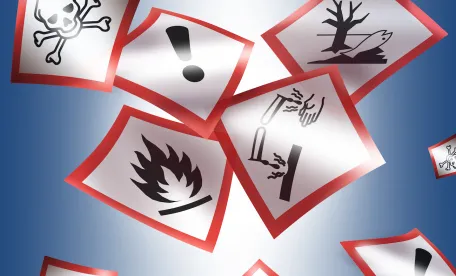Earlier this month, the Occupational Safety and Health Administration (“OSHA”) announced proposed amendments to the Hazard Communication Standard (“HCS”) in 29 CFR 1910.1200. The last time OSHA amended the HCS was in 2012 to align the standard with the United Nations’ Globally Harmonized System of Classification and Labeling of Chemicals (“GHS”) and to create consistency with other countries in chemical hazard classification, labeling, and communication. Before 2012, the HCS required manufacturers, importers, and employers to evaluate the chemicals they produced, imported, and used for possible hazards and communicate hazard information to downstream workers using container labeling and safety data sheets (“SDS”). To protect employees from chemical hazards, employers were also required to have written hazard communication programs and employee training. These measures were not, however, always done consistently because of the varying international, federal, and state laws regulating hazardous chemical identification, classification, and hazard communication. As a result, many employers had difficulty complying with the standard and workers were often confused on chemical hazards.
In amending the HCS in 2012, OSHA had a primary goal of ensuring workers received consistent and accurate information on chemicals they used in the workplace. A second goal was to ensure effective and consistent hazard communication between manufacturers, suppliers, and employers. This, in turn, required uniformity in the methods used to identify, classify, and communicate on chemical hazards (e.g., labeling and SDS pictograms and signal words). It also required major changes in how manufacturers, importers, suppliers, and employers evaluated chemical hazards, noted hazard information on product SDSs, and development or revisions to hazard communication programs and training materials to ensure employees understood SDS and label elements. In practical effect, OSHA’s 2012 amendments constituted a broad overhaul of the HCS and took time to implement. The revised HCS, in fact, was not fully implemented until June 1, 2016 and many employers faced challenges in meeting the compliance deadlines established in the revised standard.
While OSHA’s 2012 amendments helped match the United States’ approach to management of chemical hazards with international standards, OSHA’s 2012 amendments only aligned the HCS with Revision 3 of the GHS (77 FR 17574). The United Nations has, however, published revised editions of the GHS every two years since 2002 and is currently on Revision 8, making the HCS out of date with international standards. To bring the HCS up to date, or closer to it, OSHA’s proposed rulemaking if enacted would, among other things, align the HCS with Revision 7 of the GHS and select provisions of Revision 8. But the proposed modifications to the HCS also change how employers must label some chemical products in the workplace. The proposed revisions also alter requirements for SDS content and modify protections for chemical information that may be confidential business information or trade secret.
Changes in Hazard Classifications
One major amendment proposed for the HCS is to revise criteria for the classification of certain health and physical hazards, including unstable gases, non-flammable aerosols, skin corrosion, or irritation, eye irritation, and aerosols generally. The proposed amendments would also create a new hazard class for desensitized explosives. Through these changes, certain non-hazardous products, classed under the 2012 amendments, may now need to be identified as hazardous or managed in a different hazard class. They may also need to have revised labeling and SDSs. Employers handling and using aerosol products may now also have requirements under the HCS where previously they did not. Further, manufacturers, importers, and suppliers of aerosols, desensitized explosives, and flammable gases will need to reevaluate their products and ensure proper classification, identification, labeling and communication of product hazards.
Labels and SDS Content
While OSHA’s proposed HCS amendments do not change the existing requirements for hazards to be communicated to downstream users and workers through labeling and SDSs, they would require SDS and labeling revisions. OSHA has proposed new warning language and precautionary statements in an effort to help clarify chemical hazards to workers. Some language proposed in the amendments at first appears to be more of a stylistic change than substantive. For example, rather than say “during pregnancy/while nursing,” the new precautionary statement language would state “during pregnancy and while nursing.” But the effect of this change is significant in that now both the scenario of pregnancy and nursing must be addressed on the product label and SDS where before only one may have been on the label. Other proposed changes introduce entirely new statements for hazard classes and categories. OSHA has more proposed new precautionary pictograms and mandatory language.
Even though the proposed changes would require many chemical manufacturers, importers, and suppliers to revise and update certain products’ SDSs and labels, OSHA’s proposed rule contemplates that these revisions will be easy to make. Indeed, OSHA’s proposed rulemaking suggests that effected employers can make required changes consistent with the HCS’s existing requirement to update SDSs and labels whenever new information is available and within three and six months, respectively.
Cooperation with International Trading Partners and Federal Agencies
A key goal in OSHA’s proposed amendments to the HCS is to facilitate cooperation with international trading partners and federal agencies. This goal is particularly relevant to chemical manufacturers, suppliers, and importers who operate internationally, in that having consistent use of GHS across countries can reduce inconsistencies in chemical management compliance obligations. OSHA’s attempts to harmonize its procedures with other federal agencies is refreshing and the proposed amendments both consider how many regulatory frameworks a product may be subject to and seek alignment in imposed obligations. Chemical hazards may, for instance, be subject to requirements imposed by OSHA, the Department of State, the Department of Transportation (“DOT”), the Environmental Protection Agency (“EPA”), the U.S. Coast Guard, the Consumer Product Safety Commission (“CPSC”), the Department of Energy (“DOE”), the Department of Defense (“DOD”), and the Bureau of Alcohol, Tobacco, Firearms, and Explosives (“ATF”). Along with leading an U.S. Interagency GHS Coordinating Group and working with representatives of these other federal agencies, OSHA is also actively collaborating with EPA to address health hazards from chemicals consistently. EPA has, for example, proposed changes to its regulations on significant new uses of chemical substances under the Toxic Substances Control Act (“TSCA”) to align with the HCS and the GHS (81 FR 49598).
OSHA’s proposed amendments would also provide flexibility in labeling when the product is already labeled for shipment consistent with DOT regulations. For instance, OSHA has proposed new HCS language addressing requirements for bulk shipments that allows labels to be placed on the immediate container or transmitted with shipping papers, bills of lading, or electronically. This approach would ensure hazard information is immediately available to workers on receiving the shipment of hazardous chemical products but allows for different approaches in how hazard communication is achieved. The proposed amendments would also allow for use of a DOT required pictogram on the label of a shipped container, without requiring additional placement of the HCS pictogram for the same hazard.
Unique Circumstances
On top of updating the HCS, aligning with more recent revisions of the GHS, and ensuring consistent management of chemical hazards with federal agencies, OSHA’s proposed amendments aim to make the standard more effective in certain unique circumstances. OSHA has specifically included proposed HCS amendments on labeling of small containers and relabeling of chemicals for shipment. Small container labeling has been of significant interest to the regulated community because many manufacturers and importers reported they could not comply with the HCS’s labeling requirements for small containers during public meetings and requests to the agencies. Though OSHA has tried to address these issues in several letters of interpretation, the proposed amendments would specifically address how containers should be labeled when the label is too small to note all required safety information, including all information required would cause readability issues, and challenges associated with fold-out labels.
OSHA has similarly proposed changes to the requirements for relabeling of chemicals that have a long or complex distribution chain. Complex distribution chains include, for example, products that are manufactured and then shipped to a distributor where there are then held for a long time before distribution to an end user. Another example is product returns from downstream users that are then shipped from the distributor to other customers. In effect, OSHA’s proposed amendments eliminate relabeling in these scenarios, provided products are clearly labeled and hazards are effectively communicated.
OSHA has even more proposed two key changes to the HCS on trade secrets and proprietary information. Presently, OSHA does not allow manufacturers to claim concentration ranges as trade secrets. But under the proposed amendments manufacturers, importers, and employers would not have to disclose chemical concentration ranges on SDSs or labels if claimed as a trade secret and would instead use a prescriptive concentration range. This approach would fit with other country’s requirements for disclosure of substance ingredients and provide greater protection for confidential business information and trade secrets. Federal agencies would also still have avenues for learning of the substance ingredients if needed. OSHA, in particular, can obtain confidential business information on a specific chemical product in collaboration with EPA under the agencies’ memorandums of understanding and interagency working groups.
Considerations for Employers
OSHA’s proposed HCS amendments are substantial and would impact manufacturers, importers, suppliers, and employers. Employers, in fact, would need to review their product inventories, ensure proper product classification, as well as update their written programs, SDSs, and training materials. Employers may also need to modify their labeling procedures and methods of communicating chemical hazards. Once these changes are complete, employers will further have to roll out training to affected managers, supervisors, and employees. Implementing such extensive changes could be difficult for some employers, particularly if already facing competing compliance and resource priorities and demands caused by unforeseen challenges from the coronavirus pandemic.
Ways to Participate in the Rulemaking
OSHA’s notice of proposed rulemaking to amend the HCS asks interested parties to submit comments on the proposed changes. Comments, including requests for a public hearing on the proposed rule, must be submitted to the Federal Register for Docket No. OSHA-2019-0001 by April 19, 2021. If requests for a hearing are submitted during the comment period, OSHA will schedule an informal public hearing for interested parties to testify on the effect of the proposed rule and introduce evidence on the rule’s potential impact.




 />i
/>i

